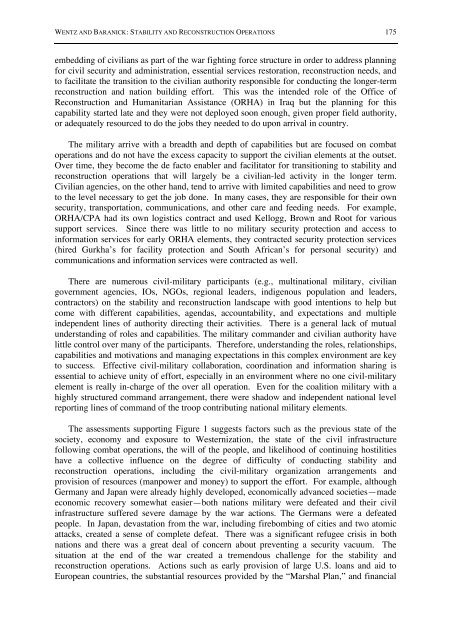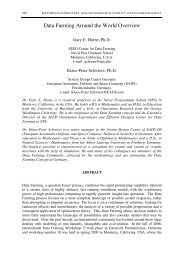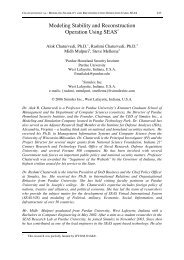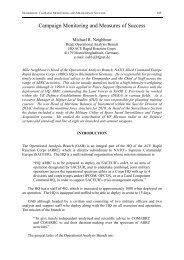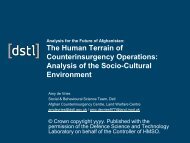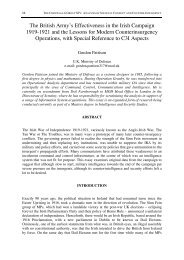Stability and Reconstruction Operations: What ... - Cornwallis Group
Stability and Reconstruction Operations: What ... - Cornwallis Group
Stability and Reconstruction Operations: What ... - Cornwallis Group
Create successful ePaper yourself
Turn your PDF publications into a flip-book with our unique Google optimized e-Paper software.
WENTZ AND BARANICK: STABILITY AND RECONSTRUCTION OPERATIONS 175<br />
embedding of civilians as part of the war fighting force structure in order to address planning<br />
for civil security <strong>and</strong> administration, essential services restoration, reconstruction needs, <strong>and</strong><br />
to facilitate the transition to the civilian authority responsible for conducting the longer-term<br />
reconstruction <strong>and</strong> nation building effort. This was the intended role of the Office of<br />
<strong>Reconstruction</strong> <strong>and</strong> Humanitarian Assistance (ORHA) in Iraq but the planning for this<br />
capability started late <strong>and</strong> they were not deployed soon enough, given proper field authority,<br />
or adequately resourced to do the jobs they needed to do upon arrival in country.<br />
The military arrive with a breadth <strong>and</strong> depth of capabilities but are focused on combat<br />
operations <strong>and</strong> do not have the excess capacity to support the civilian elements at the outset.<br />
Over time, they become the de facto enabler <strong>and</strong> facilitator for transitioning to stability <strong>and</strong><br />
reconstruction operations that will largely be a civilian-led activity in the longer term.<br />
Civilian agencies, on the other h<strong>and</strong>, tend to arrive with limited capabilities <strong>and</strong> need to grow<br />
to the level necessary to get the job done. In many cases, they are responsible for their own<br />
security, transportation, communications, <strong>and</strong> other care <strong>and</strong> feeding needs. For example,<br />
ORHA/CPA had its own logistics contract <strong>and</strong> used Kellogg, Brown <strong>and</strong> Root for various<br />
support services. Since there was little to no military security protection <strong>and</strong> access to<br />
information services for early ORHA elements, they contracted security protection services<br />
(hired Gurkha’s for facility protection <strong>and</strong> South African’s for personal security) <strong>and</strong><br />
communications <strong>and</strong> information services were contracted as well.<br />
There are numerous civil-military participants (e.g., multinational military, civilian<br />
government agencies, IOs, NGOs, regional leaders, indigenous population <strong>and</strong> leaders,<br />
contractors) on the stability <strong>and</strong> reconstruction l<strong>and</strong>scape with good intentions to help but<br />
come with different capabilities, agendas, accountability, <strong>and</strong> expectations <strong>and</strong> multiple<br />
independent lines of authority directing their activities. There is a general lack of mutual<br />
underst<strong>and</strong>ing of roles <strong>and</strong> capabilities. The military comm<strong>and</strong>er <strong>and</strong> civilian authority have<br />
little control over many of the participants. Therefore, underst<strong>and</strong>ing the roles, relationships,<br />
capabilities <strong>and</strong> motivations <strong>and</strong> managing expectations in this complex environment are key<br />
to success. Effective civil-military collaboration, coordination <strong>and</strong> information sharing is<br />
essential to achieve unity of effort, especially in an environment where no one civil-military<br />
element is really in-charge of the over all operation. Even for the coalition military with a<br />
highly structured comm<strong>and</strong> arrangement, there were shadow <strong>and</strong> independent national level<br />
reporting lines of comm<strong>and</strong> of the troop contributing national military elements.<br />
The assessments supporting Figure 1 suggests factors such as the previous state of the<br />
society, economy <strong>and</strong> exposure to Westernization, the state of the civil infrastructure<br />
following combat operations, the will of the people, <strong>and</strong> likelihood of continuing hostilities<br />
have a collective influence on the degree of difficulty of conducting stability <strong>and</strong><br />
reconstruction operations, including the civil-military organization arrangements <strong>and</strong><br />
provision of resources (manpower <strong>and</strong> money) to support the effort. For example, although<br />
Germany <strong>and</strong> Japan were already highly developed, economically advanced societies—made<br />
economic recovery somewhat easier—both nations military were defeated <strong>and</strong> their civil<br />
infrastructure suffered severe damage by the war actions. The Germans were a defeated<br />
people. In Japan, devastation from the war, including firebombing of cities <strong>and</strong> two atomic<br />
attacks, created a sense of complete defeat. There was a significant refugee crisis in both<br />
nations <strong>and</strong> there was a great deal of concern about preventing a security vacuum. The<br />
situation at the end of the war created a tremendous challenge for the stability <strong>and</strong><br />
reconstruction operations. Actions such as early provision of large U.S. loans <strong>and</strong> aid to<br />
European countries, the substantial resources provided by the “Marshal Plan,” <strong>and</strong> financial


